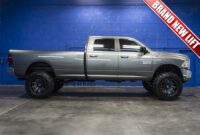24 Volts LED Truck Lights: Illuminating the Road Ahead with Power and Precision sale.truckstrend.com
In the demanding world of commercial trucking, where long hauls, adverse weather, and the relentless pursuit of efficiency are daily realities, every component plays a critical role. Among the most vital are the lights that guide these behemoths through the darkest nights and the thickest fogs. While 12-volt systems dominate passenger vehicles, heavy-duty trucks, buses, and commercial vehicles overwhelmingly rely on robust 24-volt electrical systems. This distinction is crucial when it comes to lighting, and that’s where 24 Volts LED Truck Lights step in, offering a superior blend of power, efficiency, and durability tailored specifically for the rigors of the trucking industry.
These specialized LED lights are engineered to operate seamlessly within a truck’s higher voltage architecture, providing unparalleled illumination while drawing less current, ensuring maximum visibility, safety, and operational longevity. Beyond mere functionality, 24V LED lights are an investment in reduced maintenance, enhanced aesthetics, and a significant upgrade over traditional incandescent or even lower-voltage halogen alternatives. This comprehensive guide will delve into every aspect of 24 Volts LED Truck Lights, from their inherent advantages to selection criteria, installation tips, and common troubleshooting, ensuring you’re fully equipped to make informed decisions for your fleet or individual rig.
24 Volts LED Truck Lights: Illuminating the Road Ahead with Power and Precision
Understanding the 24-Volt Advantage: Why 24V for Trucks?
The prevalence of 24-volt electrical systems in heavy-duty trucks isn’t arbitrary; it’s a strategic engineering choice driven by the unique demands of commercial vehicles. Unlike passenger cars, trucks require more power for their larger engines, extensive electrical accessories (like air brakes, liftgates, sleeper cabs with appliances), and long wiring runs.
Operating at 24 volts (typically from two 12V batteries wired in series) offers several distinct advantages:
- Reduced Current Draw: For a given power output (watts), a 24V system draws half the current of a 12V system (P = V * I). Lower current means less heat generated, thinner wires can be used (saving weight and cost), and there’s less strain on the alternator and electrical components.
- Minimized Voltage Drop: Over long wiring distances common in large trucks, voltage drop can be a significant issue. 24V systems experience less proportional voltage drop, ensuring consistent power delivery to all components, including lights at the far end of the trailer.
- Enhanced Reliability: Less current means less electrical stress, contributing to the overall longevity and reliability of the entire electrical system.

For lighting, this translates directly into more efficient and potentially brighter illumination without overtaxing the truck’s electrical infrastructure.
Key Benefits of 24-Volt LED Truck Lights
The shift from traditional incandescent bulbs to LED technology has been revolutionary across all vehicle types, but for 24V truck applications, the benefits are particularly pronounced:
- Superior Energy Efficiency: LEDs convert a much higher percentage of electrical energy into light and less into heat compared to incandescent bulbs. This lower current draw reduces the load on the truck’s electrical system, potentially improving fuel efficiency slightly and extending battery life.
- Exceptional Durability and Longevity: Designed without fragile filaments, LEDs are highly resistant to vibrations, shocks, and impacts – conditions that are commonplace in truck operations. This inherent robustness translates to a significantly longer lifespan, often exceeding 50,000 hours, drastically reducing replacement frequency and maintenance costs.
- Enhanced Brightness and Visibility: 24V LED truck lights typically offer brighter, crisper illumination than their traditional counterparts. This improved light output significantly enhances driver visibility, especially during night driving or in inclement weather, directly contributing to road safety. Their often whiter light (higher Kelvin temperature) mimics daylight, reducing eye strain.
- Instant On/Off: Unlike some traditional lights that require a warm-up period, LEDs provide instant, full brightness. This is crucial for brake lights and turn signals, offering immediate communication to other drivers.
- Reduced Maintenance & Downtime: The "fit and forget" nature of LEDs means less time spent replacing burnt-out bulbs and more time on the road, maximizing operational uptime for commercial fleets.
- Vibration Resistance: A critical factor for heavy-duty vehicles, LEDs are solid-state devices, making them inherently more resistant to the constant vibrations experienced on long hauls, unlike filament bulbs that can easily break.
- Modern Aesthetics: Beyond functionality, 24V LED lights lend a contemporary, professional look to any truck, enhancing its overall appearance.


Types of 24-Volt LED Truck Lights
The diverse needs of commercial vehicles have led to a wide array of 24V LED lighting solutions:
- Headlights: Available as complete sealed beam units or as replacement bulbs (H4, H7, etc.) for existing housings. They offer superior high beam reach and low beam cut-off for improved safety and reduced glare.
- Tail Lights: Integrated units combining brake, running, and turn signals, often with sequential turn indicators for added visibility.
- Marker/Clearance Lights: Essential for outlining the truck’s dimensions, these small but vital lights are found on the sides, top of the cab, and trailer. They come in various colors (amber, red, clear) and shapes.
- Auxiliary/Work Lights: Designed for specific tasks, these include powerful floodlights for illuminating work areas around the truck, spotlights for long-distance visibility, or combination beams. They are crucial for loading/unloading, maintenance, or off-road navigation.
- Interior Lights: From dome lights in the cab to sleeper cabin illumination, 24V LED interior lights provide bright, efficient lighting that can significantly improve comfort and productivity for drivers.
- Emergency/Strobe Lights: For specialized vehicles like recovery trucks, construction vehicles, or law enforcement, these provide high-visibility warning signals in various flash patterns.
- Decorative/Accent Lights: Though not strictly functional, underglow, grille lights, or interior accent lighting can enhance the truck’s appearance and personalize the rig.
Important Considerations When Choosing 24-Volt LED Truck Lights
Selecting the right 24V LED lights involves more than just picking the brightest option. Thoughtful consideration of these factors will ensure optimal performance and longevity:
- Voltage Compatibility (Crucial!): Always ensure the lights are explicitly rated for 24 volts. Attempting to run 12V LEDs on a 24V system will immediately burn them out, while 24V LEDs will be dim or non-functional on a 12V system. Some lights are "multi-voltage" (e.g., 10-30V), offering flexibility.
- Brightness (Lumens/Lux): Lumens measure total light output, while Lux measures illuminance at a specific distance. Choose brightness appropriate for the application. Headlights need to be powerful but also have a proper beam pattern to avoid blinding oncoming traffic. Work lights can be extremely bright.
- Beam Pattern: For headlights, a clear cut-off for low beams is essential. For work lights, decide between a wide flood, a focused spot, or a combination beam based on your illumination needs.
- Durability Ratings (IP Rating): The Ingress Protection (IP) rating indicates resistance to dust and water. For exterior truck lights, look for IP67 or IP68, signifying complete dust protection and ability to withstand immersion in water.
- Material Quality: Look for robust housings, typically die-cast aluminum, for efficient heat dissipation (crucial for LED longevity) and resistance to corrosion and impact. Lenses should be made of durable polycarbonate (PC) to resist yellowing and cracking.
- Heat Dissipation: LEDs generate heat at their base. Adequate heat sinks (fins on the back of the light) are vital to dissipate this heat, preventing premature failure.
- Compliance & Certifications: For external lights (headlights, tail lights, marker lights), ensure they meet relevant regulations like DOT (Department of Transportation) in the USA, SAE (Society of Automotive Engineers), or E-mark in Europe. This ensures they are legal and safe for road use.
- Warranty & Brand Reputation: Invest in reputable brands that offer a solid warranty. This reflects confidence in product quality and provides recourse if issues arise.
- Installation Complexity: Some lights are direct plug-and-play replacements, while others may require minor wiring modifications or the addition of relays or load resistors.
Installation and Maintenance Tips for 24-Volt LED Truck Lights
Proper installation and minimal maintenance will maximize the lifespan and performance of your 24V LED truck lights:
- Safety First: Always disconnect the truck’s batteries before beginning any electrical work to prevent shocks or short circuits.
- Verify Voltage and Polarity: Double-check that the new lights are indeed 24V compatible. Pay close attention to positive and negative terminals to ensure correct polarity, as LEDs are polarity-sensitive.
- Secure Mounting: Ensure all lights are mounted firmly to withstand constant vibrations. Use appropriate hardware and consider adding thread locker for bolts.
- Proper Wiring: Use high-quality, appropriately gauged wiring. Solder connections or use heat-shrink connectors for durable, weather-resistant joints. Protect wires from chafing or sharp edges.
- Load Resistors/Relays (if needed): For turn signals, the lower current draw of LEDs can cause "hyper-flashing" (rapid blinking) because the truck’s flasher unit expects a higher load. Installing a load resistor in parallel or an LED-compatible flasher relay will correct this. For headlights, some trucks with CANBUS systems may require decoders to prevent error messages or flickering.
- Aiming Headlights: After installation, properly aim headlights to ensure maximum visibility without blinding oncoming drivers. This often requires professional adjustment or careful DIY using a wall or garage door.
- Regular Cleaning: Keep light lenses clean from dirt, mud, and road grime. A simple wash with soap and water is usually sufficient.
- Inspect Wiring: Periodically check wiring for signs of wear, fraying, or corrosion, especially in exposed areas.
- Professional Installation: For complex lighting systems, auxiliary lights requiring new wiring runs, or if you’re unsure about the process, professional installation by a qualified truck electrician is highly recommended.
Common Challenges and Solutions
While 24V LED truck lights offer numerous advantages, some challenges can arise:
- Flickering or Dimming: This can be caused by unstable voltage from the truck’s electrical system, loose connections, or insufficient current supply.
- Solution: Ensure clean, tight electrical connections. Check battery and alternator health. Consider adding a voltage regulator or capacitor if voltage spikes/drops are persistent.
- Radio Interference (EMI/RFI): Low-quality LEDs can sometimes emit electromagnetic interference that disrupts the truck’s radio or CB.
- Solution: Invest in high-quality LEDs from reputable manufacturers that incorporate EMI suppression circuitry. Shielding wires can also help.
- Hyper-flashing of Turn Signals: As mentioned, the low current draw of LED turn signals confuses the truck’s flasher relay.
- Solution: Install appropriate load resistors in parallel with each LED turn signal or replace the flasher relay with an LED-compatible electronic flasher.
- Moisture Ingress/Condensation: Poorly sealed lights can allow water or condensation to build up inside the lens, reducing light output and potentially damaging the LEDs.
- Solution: Always choose lights with high IP ratings (IP67/IP68). Ensure seals are intact during installation. Some lights have a small "breather" valve to equalize pressure and prevent condensation without compromising water resistance.
- CANBUS Errors: Modern trucks use a Controller Area Network (CANBUS) system to monitor electrical components. LED lights draw less current, which can be interpreted as a bulb failure, triggering dashboard error messages.
- Solution: Use CANBUS-compatible LED lights or install load resistors/decoders designed to mimic the resistance of traditional bulbs, tricking the CANBUS system.
Price Table: Representative 24 Volts LED Truck Light Options
Please note: Prices are highly variable based on brand, quality, features, and retailer. These are estimated ranges for general guidance.
| Light Type | Typical Application | Key Features | Estimated Price Range (USD) |
|---|---|---|---|
| LED Headlights (Pair) | Primary forward illumination for driving | High/Low Beam, DOT/SAE compliant, Die-cast aluminum housing, IP67/IP68 | $150 – $600+ |
| LED Tail Lights (Pair) | Rear illumination, brake, running, turn signals | Integrated functions, Sequential turn (optional), IP67/IP68, PC lens | $80 – $300 |
| LED Marker Lights | Side/cab/trailer outline, amber/red/clear | Small form factor, Surface mount/grommet mount, IP67, Vibration resistant | $5 – $30 (per light) |
| LED Work Lights | Area illumination for tasks (loading, maintenance) | Spot, Flood, or Combo beam, High Lumen output, Heavy-duty housing, IP67/IP68 | $30 – $250 (per light) |
| LED Light Bars | Supplemental long-range or wide-area illumination | Single/Dual row, Various lengths, Spot/Flood/Combo beam, IP67/IP68 | $50 – $500+ |
| LED Interior Lights | Cab, sleeper, cargo area illumination | Dome lights, Strip lights, Low power draw, Easy installation | $10 – $70 (per light/strip) |
| LED Strobe/Warning Lights | Emergency/Service vehicle warning | Various flash patterns, High visibility, Magnetic/Bolt mount, IP67 | $50 – $400+ |
| Load Resistors (Pair) | Prevents hyper-flashing for LED turn signals | Heat sink design, Easy wiring | $10 – $25 |
Frequently Asked Questions (FAQ) about 24 Volts LED Truck Lights
Q1: Can I use 12-volt LED lights on my 24-volt truck?
A1: Absolutely NOT, unless the specific product is explicitly rated as "multi-voltage" (e.g., 10-30V DC). Using 12V lights on a 24V system will cause them to burn out instantly due to overvoltage. Always verify the voltage compatibility.
Q2: Are 24-volt LED truck lights brighter than 12-volt LED lights?
A2: Not inherently. The voltage (12V vs. 24V) refers to the power supply, not the brightness itself. Brightness is measured in lumens. However, a 24V system can often efficiently power more powerful (higher lumen) lights due to reduced current draw and less voltage drop over long wiring runs.
Q3: How long do 24-volt LED truck lights typically last?
A3: High-quality 24V LED truck lights are designed for extreme longevity, often lasting 30,000 to 50,000 hours or more. This is significantly longer than incandescent bulbs (around 1,000-5,000 hours) and even many halogen bulbs.
Q4: Do I need a special relay or resistor for 24V LED turn signals?
A4: Yes, often. Just like with 12V systems, the lower current draw of LED turn signals can cause the truck’s flasher relay to "hyper-flash" (blink too quickly) because it expects a higher load. You’ll typically need to install a load resistor in parallel with each LED turn signal or replace the mechanical flasher relay with an LED-compatible electronic one.
Q5: What does the IP rating (e.g., IP67) mean for truck lights?
A5: IP stands for Ingress Protection. The first digit indicates protection against solids (dust), and the second digit indicates protection against liquids (water). IP67 means the light is completely protected against dust ingress (6) and can withstand immersion in water up to 1 meter for 30 minutes (7). IP68 offers even greater water resistance. For truck lights, higher IP ratings are crucial for durability in harsh environments.
Q6: Are all 24V LED truck lights street legal?
A6: No. For external lighting like headlights, tail lights, and marker lights, they must comply with regional regulations (e.g., DOT/SAE in the US, E-mark in Europe). Always look for these certifications to ensure legality. Auxiliary and work lights are often not street-legal for use while driving on public roads and are intended for off-road or task-specific use.
Q7: Can I install 24V LED truck lights myself, or do I need a professional?
A7: For simple, direct replacements (e.g., swapping out a marker light), many truck owners can do it themselves with basic tools and electrical knowledge. However, for complex installations involving new wiring runs, multiple auxiliary lights, or dealing with CANBUS systems, professional installation by a qualified truck electrician is recommended to ensure safety, proper function, and compliance.
Conclusion
24 Volts LED Truck Lights are far more than just a lighting upgrade; they represent a significant enhancement in safety, efficiency, and operational longevity for heavy-duty vehicles. By leveraging the inherent advantages of a 24-volt electrical system with the cutting-edge technology of LEDs, these lights provide unparalleled visibility, reduce maintenance demands, and offer a modern aesthetic that reflects the advanced engineering of today’s commercial trucks.
Choosing the right 24V LED lights requires careful consideration of factors like voltage compatibility, brightness, durability ratings, and regulatory compliance. However, the investment pays dividends through reduced downtime, improved driver confidence, and a lower total cost of ownership over the lifespan of the vehicle. As the trucking industry continues to evolve, 24 Volts LED Truck Lights stand as a testament to the ongoing pursuit of excellence, illuminating the road ahead with power, precision, and unwavering reliability.



